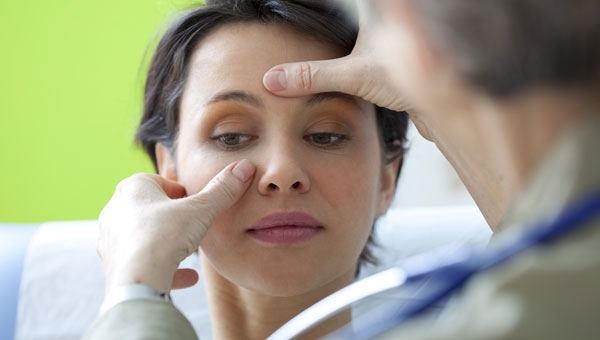Sinus Pressure is a result of sinus ailments, allergies, flu, colds and many other factors.
During these conditions, membranes of the sinuses and the nose may swell, and mucus may build up in the ostia, hindering airflow. The air traps within the sinus and dissolves into the mucosa of the sinus. The pressure of the air within the sinus, therefore, falls to levels lower than the pressure level outside. This is perceived as pressure in face. However, generally, these pressure changes cause only temporary discomfort. If germs grow in the mucus, resulting infection may aggravate sinus pressure. The pressure may also be accompanied by pain in the teeth, forehead, nose and eyes. The frontal sinus region may become tender. Sinus pressure may cause headache due to under ventilated sinuses.
Treatment
To relive the pressure, mucus build up blocking the passages should be cleaned up. Several over-the-counter (OTC) drugs for sinus pressure are available in the market. Most of which consists of an antihistamine or a decongestant and acetaminophen or other painkillers. The OTCs play fourfold role: clear nasal passages, reduce nasal congestion, relieve symptoms of pressure, and minimize chances of complications.
Inhalers, nasal sprays and steam may relieve the pressure temporarily. Breathing the vapors or eucalyptus, menthol or other aromatic substances ease up the congestion within the sinuses and nasal passages. Sipping peppermint tea containing menthol may also help. Drink more fluids, but avoid caffeine-based beverages.
Constant change in air pressure of the cabin within airplane causes sinus pressure even in healthy travelers. This pressure increases in travelers suffering from sinus disorders. The dry air within the airplane also has a direct impact on the sinuses, especially on already infected ones. Doctors generally advise people suffering from sinus infection not to travel by air. However, if flying is unavoidable, take medicine before take-off to reduce the pressure. Use saline nasal spray to moisten the nose during the flight.
If you do not have sinus infection but pressure is an issue while flying, chew a gum during take-off. Swallow water when the airplane levels out. After landing, try “valsalva maneuver” technique to relieve the pressure. However, follow the correct technique, otherwise it may damage eardrums or sinuses.
Use earplugs to minimize impact of pressure change while flying. The earplugs ensure that change in air pressure occur slowly. Use hot compresses while flying.
